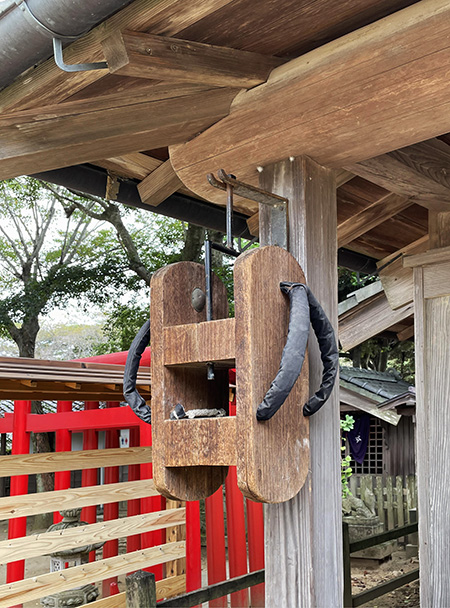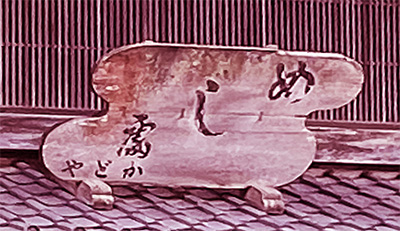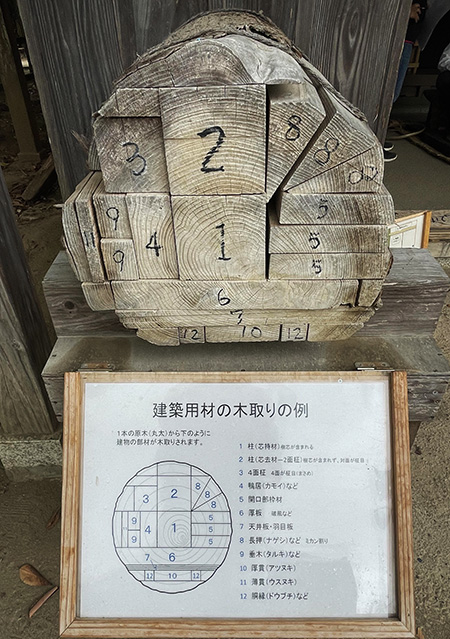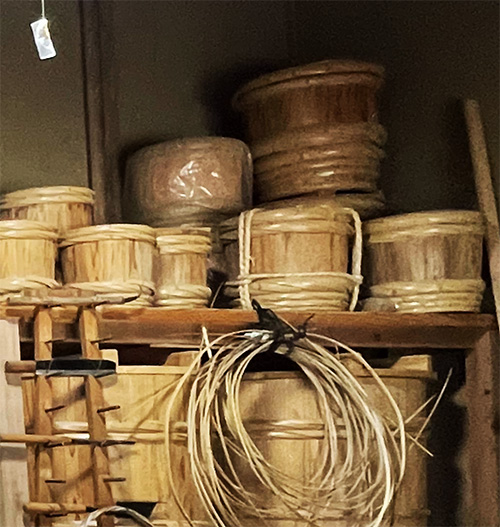

古民家でも商家となると現代の資本主義的なビジネス感覚と相似するカタチがみえてくる。写真は「木工屋」の店先・隅柱に掛けられた「下駄」のPOPと先日紹介の「めしや」の看板。昨日「樽つくり」の様子も見たけれど、木を使って造作することは生活に密着した手工業だった。化学素材が出現するより前の時代には、木のような自然素材が生活領域すべてをほぼ覆っていた。化学素材でのものづくりでは必然的に工業化された集中生産が進展し、一般社会からの「疎外」が当たり前になる。現代生活での日常必需品では手づくりというのはむしろ少数派で、大部分はどこで誰がつくっているか想像力が及ばないのが普通。言われてみてはじめてそれが他国でつくられていることを知るのが一般的。
一方で木のような自然素材の日用品が主体の江戸期までの社会では、それこそ製造業が「家内制」であって、需要地域に深く根ざして存在していた。江戸期までは履物といえば下駄が主流であっただろうから、このようなPOPが木工の主用途を表現したのだろう。「なんでも木で作るモノならつくりますよ」というメッセージが伝わってくる。
わたしは昭和中期に生まれた年代だけれど、都市居住ではこのような「◎◎屋」という存在が日常語として頻繁に使われていた。それが街のランドマークでもあり、向こう三軒両隣のような範囲でふつうの空気感として存在していた。八百屋・魚屋など生業が明確な存在が街の表情を形成していた。それがスーパーというような流通形態が主流になって企業規模が拡大していって「近代化」が進んだ。こういったありようにはノスタルジーが感じられ、独特の人間くささも薫っている。
こういったPOPの表現にはわかりやすさと同時にその作り手の個性、人間性も伝わる部分があるのではないか。まるで擬人化・マンガ文化力のようなものも感じさせられる。店に入るときに、その人となりの幾分か、応答内容が予測されるものがあると思える。


街並み再現構成のカタチとしてイマドキの子どもたちにもわかりやすいように、店頭には木割りの模型とか、樽の実物展示などがされている。木造住宅でも現代では構造が隠される「大壁」的な仕上げが多いので、柱梁が直接露出している方が少数派。現代住宅で育った子どもたちにはこういった部分から「構造を知らせる」きっかけを働きかける必要もあるでしょうね。またそもそも「樽」などという実物を見る機会もほとんどないだろう。化学素材製ではないモノの個性の豊かさというものに大いに驚いて欲しいと思う。化学素材製品のさらなる発展のためにも、その創造の原点としての自然素材の「肌ざわり・質感」というものがバネとして働くと思う。現代の子どもたちの新鮮な感受性を刺激するには、こういう機会を大人たちがもっと意識的に作って行くことが大切ではないか。
English version⬇
Store POP advertisement “Woodwork shop-2” Bustling townhouse in Bossou, Edo period – 3
Humorous POP with a strong message. The cradle of Japanese sensibility, which is connected to manga culture. Appealing to children’s hearts and minds. The “Bosho Machiya-2” and “Bosho Machiya-3” are the most popular.
Even in old private houses, when it comes to merchant houses, one can see forms that resemble the capitalistic business sense of today. The photo shows “geta” POP hanging on the corner post of a woodworking shop and the signboard of “meshiya” introduced the other day. I also saw a scene of “barrel making” yesterday, and the use of wood in manufacturing was a handicraft closely related to daily life. Before the advent of chemical materials, natural materials such as wood covered almost all areas of daily life. Manufacturing with chemical materials inevitably assumes industrialized, intensive production, and “alienation” from general society becomes the norm. In modern life, handmade products for daily necessities are in the minority, and it is common for people to have no idea where most of them are made. It is only when they are told that they are made in other countries that they realize that they are made in other countries.
On the other hand, until the Edo period, when daily necessities were mainly made of natural materials such as wood, the manufacturing industry was a “cottage industry” that was rooted in the area of demand. Until the Edo period, geta (wooden clogs) would have been the most common type of footwear, so this type of POP would have represented the main use of woodworking. It conveys the message, “We can make anything out of wood.
I was born in the mid-Showa period (1926-1989), and in urban areas, this kind of “◎◎ shop” was frequently used as an everyday word. It was a landmark of the town, and existed as a common atmosphere in the neighborhoods across the street from each other. Grocers, fishmongers, and other businesses with clear lines of business formed the face of the town. Then, supermarkets and other forms of distribution became the mainstream, and the scale of business expanded, which probably contributed to the “modernization” of the town. This way of being is nostalgic, but it also has a unique humanistic flavor.
This kind of POP expression is not only easy to understand, but also conveys the individuality and humanity of the owner. It is like the power of anthropomorphism and manga culture. When you enter a store, some of the responses of the owner’s personality can be predicted.
In order to make it easy for children of today’s generation to understand the form of the townscape reproduction composition, models of wood splits and actual barrels are displayed in the storefront. In modern wooden houses, many of them are finished with large walls, so exposed pillars and beams are more common in the minority. It is probably necessary to encourage children who have grown up in modern houses to learn about the structure from these types of structures. In the first place, there are probably few opportunities to see actual “barrels. I would like them to be surprised at the richness of individuality of products that are not made of chemical materials. For the further development of products made of chemical materials, the “feel and texture” of natural materials as the starting point of their creation will act as a springboard. In order to further stimulate the fresh sensibilities of today’s children, it is important for adults to consciously create such opportunities.
Posted on 1月 9th, 2023 by 三木 奎吾
Filed under: 日本社会・文化研究







コメントを投稿
「※誹謗中傷や、悪意のある書き込み、営利目的などのコメントを防ぐために、投稿された全てのコメントは一時的に保留されますのでご了承ください。」
You must be logged in to post a comment.